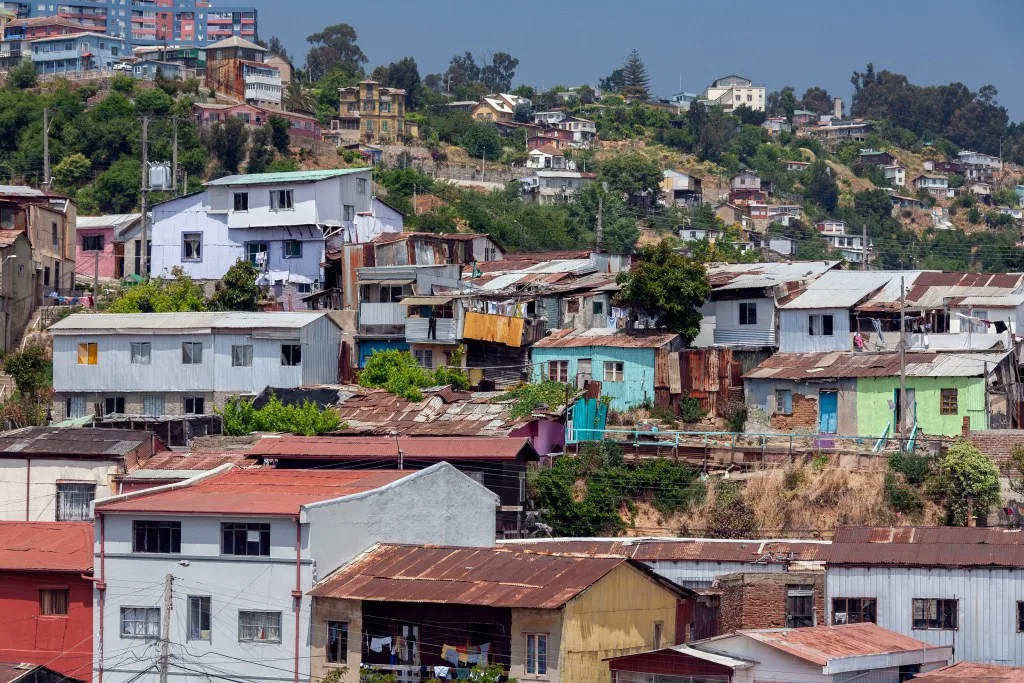Wandering off into the unknown places of the world sounds like quite an exhilarating adventure for many people. And it should be. A trek across Antarctica, a Tasmanian expedition, even a Mongolian Shaman tour — many people seek this type of travel instead of a trip to Paris or London.
It’s understandable that people are seeking different vacation experiences, but should slum tourism be the same? An off-the-beaten-path adventure? What exactly is slum tourism?
If you’ve never heard of this term, it’s time to learn more because it could be the next big thing for tourists, and that might not be good at all.
What Is a Slum?
A slum got its name in London in the early 1800s as an area of ill-repute. The United Nations has long since redefined slums as “a contiguous settlement where the inhabitants are characterized as having inadequate housing and basic services.”
In some of the world’s largest slums, you’ll find deplorable conditions. These areas lack waste management and running water. Many places even have sewage running down the streets.
The people have limited, if any, electricity; tin roofs and walls balanced precariously against each other, offering very little privacy. You’ll often find no formal toilets and no land or house titles.
Additionally, the people here have limited access to healthcare, schools, and almost everything many of us take for granted.
These areas are also not deemed a part of a city, resulting in continued decay and a lack of basic services. And with millions of people residing in slums across the globe, slums are in fact, cities.
Three of some of the largest slums in the world include Orangi Town in Karachi, Pakistan, with 2.4 million inhabitants, and Neza, Mexico, with 1.2 million persons. Third, we have the Dharavi slum in Mumbai, India, with 1 million residents.
Additionally, Khayelitsha in Cape Town, South Africa, has 400,000 residents, and Kibera in Nairobi, Kenya, with 700,000 people.
According to Habitat for Humanity, low estimates report that around 900 million people live in slums worldwide.

What Is Slum Tourism?
It’s easy to think that anything with the word tourism in it equates to a vacation — one filled with adventure and excitement. And slum tourism might be that way, too, just not quite how you may envision it.
Slum tourism at the very heart of those two words is exactly what it sounds like — tourists visiting slums. This growing trend involves traveling to these impoverished areas.
Slum tours typically focus on the stark realities of living in such areas with little access to basic amenities, such as housing and sanitation.
However, some argue that slums can also offer cultural vibrancy. After all, slums are home to many local businesses, such as banks, hospitals, and entertainment venues.
Slum tourists need to approach this in a dignified manner by viewing these areas through the lens of what makes them unique instead of being judgmental about other people’s lives and poverty.
Why Is There Slum Tourism?
And maybe that is why there is slum tourism. If done ethically and with integrity, traveling to a slum to visit a different place can allow people to see what life is like outside of their own.
Slum tourism has become increasingly popular as a form of unconventional tourism, providing those interested with an often very real view into the conditions experienced by poorer populations in developing nations.
This type of tourism can prompt people to open their eyes and become more aware of social inequalities around the world. And it can educate individuals about economic hardship and encourage reflection and conversations about poverty.
Pro Tip: Get the inside scoop about RV Medical Tourism: Despite the Downsides, RVers Love It.

How Did Slum Tourism Begin?
An article published by National Geographic helps explain the origin of slum tourism. Beginning around the mid-1800s in East London, wealthy citizens gave the impression that they were visiting struggling neighborhoods for charitable work. Instead, they just wanted to see what life was like “on the other side of the tracks.”
Spreading to cities outside of England, this became a regular practice for tour operators to bring tourists into poverty-stricken neighborhoods so people could experience the “real” side of cities such as New York, Chicago, and even San Francisco.
Not wanting to disappoint the tourists, some groups even went so far as to hire paid actors to act as though they were drug addicts or gang members. They didn’t want the tourists to feel disappointed if they didn’t experience the expected poverty-stricken activities.
Slum tourism dissipated during the mid-1990s until it became popular again in South Africa due to apartheid. Communities chose to share their neighborhoods in hopes of creating increased awareness of the effects the apartheid had on them.
In this way, they took control, telling their own stories, and helping to promote education and service instead of gawking and possible exploitation.
Since then, slum tourism has flourished, with many charities that claim to assist. However, many don’t provide what the residents need or want or keep more for themselves.
Are There Any Benefits to Slum Tourism?
This type of tourism can provide an opportunity to gain a deeper understanding of different cultures and lifestyles in ways going beyond just visiting tourist hotspots.
It can open people’s eyes to real issues like poverty and bring awareness worldwide.
Perhaps most importantly, slum tourism can provide funds that could manifest as job opportunities, businesses, and resources for those living within the slums, helping them to improve their lives.
Therefore, we don’t want to write off slum tourism completely. With proper guidelines and research ahead of time, it can benefit those seeking an understanding of unfamiliar living conditions.

What Are the Impacts of Slum Tourism?
The trend of slum tourism has grown in recent years, but many people debate its impacts. On the one hand, some argue that slum tourism can bring economic benefits to locals and create jobs and income for guides and other area businesses.
On the other hand, slum tourism could have a negative impact on its visitors. Critics argue that tourists may not understand the local culture and customs, which could result in insensitive behavior toward residents.
Additionally, slum tours can exploit the people and their conditions. Some tourists don’t wish to improve living conditions and only take pictures from afar.
Also, certain tourism agencies say the money spent will flow back into communities when in reality, it only goes into the pockets of the scammers.
Slum tourism carries many complex considerations that one should take seriously before considering this type of travel.
What Are the Arguments Against Slum Tourism?
As was mentioned previously, slum tourism can be a meaningful way to engage individuals from all backgrounds in important conversations. These conversations can help to create more understanding between different social strata while potentially providing some benefit to those living in slums.
But many argue against slum tourism. Slum tours often devalue certain cultures or destigmatize poverty by providing a movie-like version of a reality that millions of people face.
By capitalizing on slums and their inhabitants, this type of travel has seen pushback from locals and other groups who argue that it problematically portrays slums as an attraction to be experienced and monetized.
Furthermore, the income that slum tourism brings isn’t evenly distributed. The residents in these areas often receive very little benefit.
Overall, slum tourism can present complex ethical dilemmas and raise uncomfortable questions about how we represent, understand, and ultimately engage with poverty in our world.
Should Slum Tourism Be Discouraged?
Slum tourism is a complex and often polarizing issue. You can find valid arguments on both sides of the debate surrounding its impact on the people who reside in slums.
However, it ultimately falls upon tourists to make informed decisions about whether or not this type of tourism is something they feel comfortable supporting.
In the end, you’ll have to decide for yourself if slum tourism is an ethical and responsible way to experience a new culture.
Discover the Best Free Camping Across the USA
To be honest with you, we hate paying for camping. There are so many free campsites in America (with complete privacy).
You should give it a try!
As a matter of fact, these free campsites are yours. Every time you pay federal taxes, you’re contributing to these lands.
Become a FREE CAMPING INSIDER and join the 100,000 campers that love to score the best site!
We’ll send you the 50 Best Free Campsites in the USA (one per state). Access the list by submitting your email below: